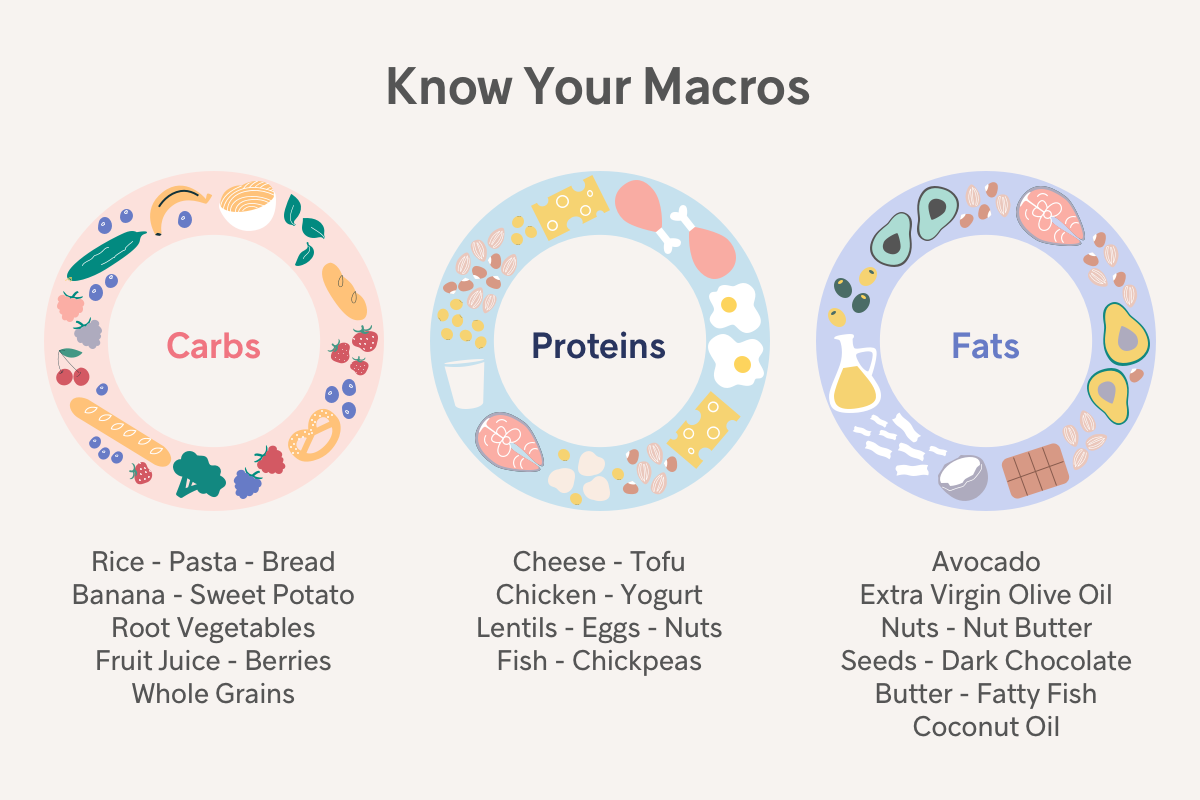Should you be crunching macros to reach your goals?

If your goal is to lose body fat, you’ve probably been researching macronutrients. While counting macros is nothing new, looking for the best macros is a topic worth discussing.
Before we jump into macro counting, let’s take a deep dive into what macronutrients really mean. In this article, you’ll find out what macronutrients are, how much you need and which foods will help you lose body fat.
What Are Macronutrients?
Macronutrients (macros) are the nutrients your body needs for energy and to function properly on a daily basis. Whether you’re already a healthy eater or you’re trying to become one, understanding macros will help you choose the foods that will keep you feeling your best.
There are 3 main types of macros: carbohydrates, protein and fats. While each macro provides energy, they function in different ways.
Carbohydrates: Give you energy and help with brain and muscle function.
Protein: Provides satiety (the feeling of fullness), repairs and builds muscle tissue and increases bone density.
Fats: Absorb vitamins, regulate metabolism and store energy.
Striking the right balance between these 3 macros is a game-changer when it comes to losing body fat.
Related: The Real Truth on Protein, Carbs & Fat
How to Track Macros

Counting your macros means monitoring how much carbs, protein and fat you’re consuming on a daily basis.
It’s recommended to consume 45-65% of your daily calories from carbs, 10-35% from protein and 15-35% from fat. You might be saying to yourself, “there’s a lot of wiggle room here.”
Here’s why…the higher percentages are recommended for extremely active people while the lower percentages are based on inactive lifestyles.
As a rule of thumb, if you’re doing a lot of cardio-intensive workouts, you’ll want to intake a higher amount of carbs (60-65%) for energy. If you regularly lift weights, you’ll want to consume a higher amount of protein (30-35%) to repair muscle tissue. And if you lead an inactive lifestyle, you’ll want to limit your fat intake (15-20%).
Next, you’ll need to figure out how many grams of each macronutrient to eat. Carbs and protein have 4 calories per gram, while fats contain 9 calories per gram.
To calculate macros, divide the total number of calories you eat in a day by the number of calories per gram for each macro.
For example, if you eat 2500 calories each day and 20% are from fat, multiply 2500 by 0.2 (% of fat), which equals 500. Divide this number (500) by 9 (the number of calories per gram in fats). This gives you a total of 55.5 grams of fats per day.
The Best Macros for Fat Loss
There’s much debate when it comes to macros for fat loss. You’ve probably heard you should limit your carbs or not have any at all. Carbs aren’t the problem—it’s the type of carbs you choose.
According to research, the following formula has proven successful when trying to decrease body fat:
50% carbs
35% protein
15% fat
Related: Foods to Enjoy All the Time, Sometimes and Rarely
What Does a Macro Meal Look Like?

An example of a plate hitting the above macros percentages would look something like this:
100 grams brown rice
150 grams steamed broccoli topped with 15 grams (1.5 tablespoons) butter
110 grams grilled chicken
This is just an example. The percentage of macronutrients your body needs depends on so many factors—things like activity level, age, weight, gender, etc.
The Pros and Cons of Tracking Macros
You don’t need to track macros (or calories) to lead a healthy lifestyle. Eating healthy is a choice. But there are some pros and cons you need to consider before determining if tracking macros is right for you.
Pros
- Beneficial for people on a vegan diet to ensure they’re getting the proper nutrients
- Helps decrease body fat
- Assists with weight management
- Increases muscle growth and endurance
- Leads to better performance and quicker recovery
Cons
- Weighing your food and calculating macros can be time-consuming
- Could lead to obsessive behaviors, especially to those with a history of eating disorders
- It can make you less social when dining out with friends or family members
Counting Calories Versus Counting Macros

What’s the key difference between counting calories and counting macros? Counting calories only measures the energy going into your body while counting macronutrients takes into account the key nutrients that your body needs to survive.
If you’re looking for a more detailed story, count macros. You’ll learn where calories are coming from and what they do in your body once consumed. For example, a handful of nuts and a handful of potato chips might have the same number of calories.
If you were to count calories alone, you’d miss out on the impact they have on your body. On the other hand, if you were to measure macronutrients, you’d find that most nuts provide healthy fats, protein and complex carbs while potato chips contain saturated fat and simple carbs.
Takeaway
Tracking macros and counting calories are both tools that can help you lose body fat. However, tracking macros gives you a more complete story, helping you understand what you’re putting into your body.
But understanding macros is just one element of developing long-term healthy habits. A holistic approach to your health and wellness is key to reaching your fitness goals. Start your free trial with Gymondo and explore 1000+ healthy recipes and 350+ workouts for your fitness level and goals. See you on the mat!







